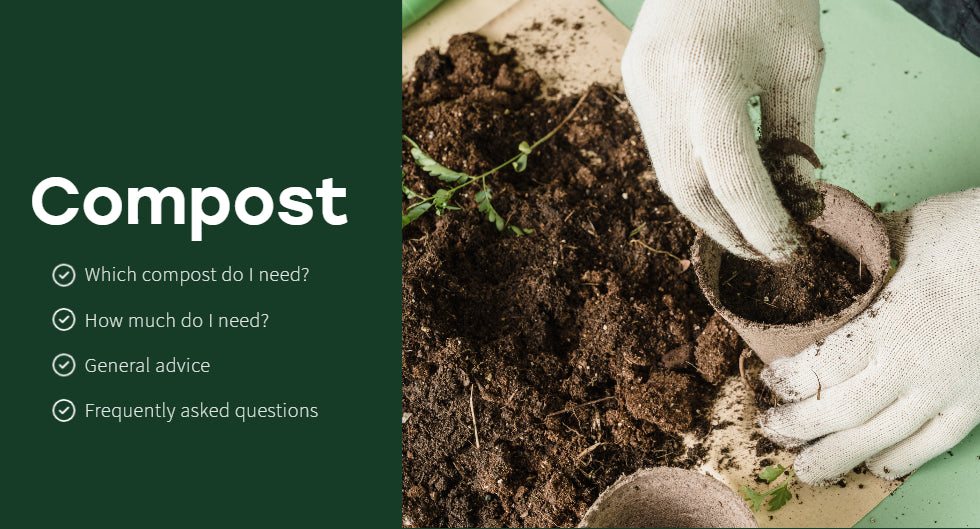The Basics
Many people use the words soil and compost interchangeably however there is a big difference between them. Compost is a mixture of vegetable waste and decayed plants which is used to fertilise and enrich soil and plants. Soil is the thin layer of material covering the Earth’s surface. It is made up of mineral particles, organic materials, air water and living organisms.
You should always use soil to plant your plants as this is what holds the nutrients and water that is necessary for plant survival.
Compost can be spread along the surface of soil or alternatively it can be mixed down through it, it will fertilise and enrich the soil and plants.
Soil that has compost added to it has fewer pest and disease problems.
General Advice
- Always wear gloves when gardening and wash hands with soap and running water after use.
- Do not use in confined spaces.
- Always cover compost when not in use.
- Always follow manufacturers safety instructions on the bag.
- Open bags of composted potting mix slowly, directing the opening away from the face to avoid inhaling the mix
Which Soil/Compost Do I Need?
There are many different types of growing media, and you may not know which type you need. Click here to check out our guide for finding the right compost for your needs.
Frequently Asked Questions
Good bagged compost should be full of nutrients and help your soil retain moisture. Look for minerals such as phosphorus, nitrogen, potassium, calcium, and magnesium. Compost should have a dark, crumbly and moist texture. Good compost should have an earthy smell
Jack’s Magic All Purpose Compost 50:50 is still a gardener’s favourite.
- New and improved blend – enriched with BIO3
- Stronger roots, more flowers and foliage
- Great for use all around the garden
- Perfect for seed sowing*, potting, planting and containers
- Still great magical results
No, it does not go bad, however it can lose structure and nutrition over time.
The general rule of thumb is 1/4 to 1/2 inch if applying to the top of the soil and 1 to 2 inches amended to 6 to 8 inches when amending into the soil. Recommended maximums are 25% to 30% compost in a soil blend, but no more than 25% compost in containers or raised beds.
Ensure compost is stored in a cool dry place. To store correctly, you will need to cover it, using a tarp, lidded bin, or in a bag, while still allowing airflow to enable oxygen to allow the composting process to continue. Without airflow, your stored compost will break down much slower.
New Horizon All Vegetable Compost
- 100% sustainable, natural and peat-free compost
- Specially blended for all types of vegetables
- Base fertiliser - feeds plants for up to 6 weeks
- Ideal for adding into raised beds
- BIO3 formulation - no green waste
- Use all year round. Use in a well-ventilated area and avoid breathing in dust. Always wear gloves when gardening and wash hands after use.
- 100% sustainable, natural and peat-free compost
- Specially blended for all types of plants
- Feeds plants for up to 6 weeks
- Perfect for seedlings, containers, fruit and vegetables
- Available in 10L, 26.7L and 60L
Not suitable for ericaceous plants. Always wear gloves when gardening and wash hands after use.
The compost includes Peat and loam for perfect nutrient, moisture retention as well as sand and grit for excellent drainage.
- Perfect for rhododendrons, azaleas & camellias
- Encourages stronger flowers & foliage
- Feeds for 4 weeks
- No Green Waste
Westland John Innes Ericaceous Compost is the ideal compost for strong, healthy ericaceous plants. It feeds for 4 weeks with added iron for maximum leaf greening. Developed specially to help all acid loving (lime hating) plants bloom & thrive.
Whatever compost you choose, for best results only buy as much as you can use within six to eight weeks, and seal after use to stop bugs and weed seeds getting in and prevent decomposition. Store it where it won't get waterlogged.
Soil Calculator
How much soil do I need?
Enter the length, width, and depth to find the volume in m³.
Length (in metres):
Width (in metres):
Depth (in in centimetres):

